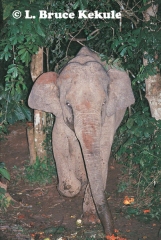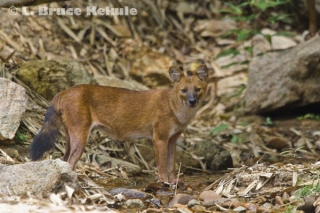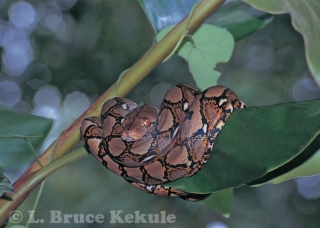Posts Tagged ‘Dangers in the wilderness’
The Perils of Wildlife Photography
The dangerous side of a great profession
Cartoon by Smith Sutibut
Wildlife photography is one of the best professions in the world. To see Mother Nature’s beautiful creatures through the lens and then later in photographs is both exciting and rewarding. Sharing these images with other people creates conservation awareness. Not many people take it up, but those who do know the real benefits. I consider myself lucky working in the field of wildlife photography full time.
But there is a dark side. Many things in the wilderness cut, bite, sting, maim and even kill. Little insects carry diseases that can stop you in your tracks if not diagnosed in time. Such was the case when I caught Plasmodium falciparum (cerebral malaria), which suddenly became a raging infection within a couple of hours. Only a complete blood exchange transfusion saved my life.
Wild elephant feeding on discarded fruit
At the top of the danger list are animals like elephant, gaur, banteng, wild water buffalo, tiger, leopard, bear, wild boar and even male deer. In the event poachers wound any of these animals, they can be very dangerous and can easily kill humans – be they wildlife photographers, nature trekkers, field researchers or park rangers. Some animals are very protective of their young especially elephants. The tiger will also closely guard and defend their kill or their young.
Nothing is scarier than an Asian elephant in dense jungle charging with the intent of crushing you, or the roar of a tiger. Gaur, banteng and wild water buffalo – when wounded – will patiently wait a few meters off the trail and charge as you approach. Wild bovid will hook you with their horns as they pass and many a hunter has suffered a painful death. Buffalo are even worse – they will also come back to trample the intruder. The Asiatic black bear and the Malayan sun bear are fierce and will literally tear you to shreds. People would be lucky to survive an encounter with any of the large mammals.
Carpenter ants in Thung Yai Naresuan Wildlife Sanctuary
A friend of mine in Sai Yok district, Kanchanaburi province in Western Thailand barely survived a tiger attack more than ten years ago. A young male tiger and its mother were killing cattle, taking many of the village cows and buffaloes. One day my friend went looking for the killers along a forest road. Spotting the young tiger crouching low a few meters away, he shot and mortally wounded it – but not before it pounced on him. He shoved his gun crosswise into the mouth of the roaring beast and kicked at it but he was bitten and slashed on his arms and legs. The tiger died shortly after with the gun in its mouth and my friend was rushed to the nearest hospital seriously wounded. He very luckily survived the incident but has many permanent scars. The incident made the front-page of a few Thai newspapers.
Asian wild dog in Kaeng Krachan National Park
Asian wild dog and feral dog can also be a serious menace when in large packs. A huge pack of more than 20 wild dogs in Khao Yai National Park has scared people walking on the trails. Another friend of mine who works in the park came across this pack and watched the dogs devour a sambar in one hour, bones and all. Feral dog are a nuisance on Doi Inthanon National Park, south of Chiang Mai, where a pack of some 30 dogs roam around the radar station on the peak. These dogs are killing off wildlife in the park such as deer and wild pig one at a time, and there is no telling what they might surround and eat in the future if the dog pack is not totally eliminated.
Reticulated python in Huai Kha Khaeng Wildlife Sanctuary
Snakes like the king cobra have attacked during nesting time in February if unsuspecting people find themselves between a mother snake and her eggs. I knew of a man in Eastern Thailand who failed to come home after three days. Family members found him with three puncture wounds on the head and shoulders, and his upper torso had turned black from the venom of a big snake.
I know someone who jumped off a boat wearing rubber thongs and romped in the jungle on Phi Phi Island near Phuket in the south, where he was bitten on the foot by a green pit viper. Only quick action by Royal Thai Navy personnel, who rushed the man to a hospital by helicopter, managed to save him. His foot went black and swelled up to twice its normal size. He was extremely lucky – doctors at a hospital in Bangkok saved his foot and possibly his life.
Green pit viper in Kaeng Krachan
Many other poisonous snakes can kill, if they bite you. I once had a scary encounter sitting on a chair in a photographic blind in Thung Yai Naresuan Wildlife Sanctuary as I waited for gaur and other animals near a mineral lick. I happened to look down when a pit viper slid between my legs from behind. A natural instinct might have been to stomp on it, but I froze and the snake continued on its way. I was at least two days travel to the nearest hospital and, if bitten, would probably not have made it back for medical treatment in time.
Very mature pythons can and will, on occasion, take people. These snakes cannot differentiate between large mammals and humans that approach them. A friend of mine was out looking for bamboo shoots in the forest when a large python took his dog some 20 meters ahead. Within seconds, the dog had been suffocated and crushed to death. He looks back on the incident and says it could easily have been him. While looking for frogs one day in a forest stream, he was chased by a big python but managed to escape.
Forest scorpion in Huai Kha Khaeng
Little arthropods like spiders, scorpions and centipedes love dark and damp places. Boots and sleeping bags are inviting to these dangerous creatures. Many of them have venomous bites and stings that can become extremely serious if not treated quickly. Bees, wasps and hornets will attack intruders who walk into their space. I was stung on the back of the head by several wasps once while running in a mango orchard. Luckily, I was not allergic to their venom. A friend running behind me had to go to hospital. His head swelled up with welts where he had been stung, and he lost consciousness. But he survived the ordeal.
During the dry season, ticks of various sizes will latch onto just about anywhere on your body. Many of them have microbes that can make humans very sick, not unlike Rocky Mountain fever and Lyme’s disease. I once had a tick that clamped on to my upper shoulder while in Nam Nao National Park in Petchabun province, Northeast Thailand. By the time I realized the tick was there, it was too late. An infection had set in and my shoulder and head throbbed for many days afterward. The bite was very itchy and bothersome for more than six months until antibiotic cream finally killed the infection.
Leech in Thung Yai Naresuan
Leeches, found in many of Thailand’s forests, are a problem for photographers or naturalists wanting to romp around in the wet season. In some areas along the Phetchaburi River in Kaeng Krachan National Park, there would be 20 to 30 leeches crawling up my pants at any one time while looking for the Siamese crocodile. I was wearing high-top combat boots, leech-proof socks and tucked-in nylon pants that prevented them from getting to my legs. But some of these tenacious bloodsuckers still climbed up and got in around my waist, wrists and neck. These invertebrates fortunately do not carry a disease, although bites can stay infected for months.
Ants can also be very annoying. Some are harmless but others are downright dangerous. A single ant bite can leave a serious welt, and getting bitten by hundreds of the little creatures can quickly create a disaster. They invade clothing or sleeping areas looking for food. Some species start biting on contact with humans. The large carpenter ant about an inch long can stop you in your tracks.
Poachers with sambar antlers in Huai Kha Khaeng
Spider web is also a nuisance that you can encounter just about anywhere. I once walked into to a web and ended up with both my eyes infected for several days. Fortunately, I always carry a good supply of medicines and had antibiotic eye cream that helped kill the infection. Some microbes in water and dirt are also very dangerous and can cause intestinal and skin problems.
One of the smallest but most irritating and dangerous of all insects is the mosquito. There are more than 420 species in the Kingdom but only three species of Anopheles carry the deadly malaria. Other dangerous diseases such as dengue and encephalitis transmitted also by the mosquito can also kill.
Poachers and dog camera-trapped in Sai Yok National Park
Malaria is one of the major diseases of the tropics. There is three strains found in Thailand: Plasmodium vivax, Plasmodium malariae and Plasmodium falciparum. The P. vivax infection can last for three years and a relapse may occur when your body’s immunity level drops. P. malariae stays with you for your entire life and P. falciparum on the other hand, strikes once and after treatment, will not return unless re-infected. All three strains have the same symptoms when infection begins, and all three are deadly.
My bout with P. falciparum was a close call. I have had P. vivax off and on for over 30 years. But this time I misjudged the infection and delayed for four days before going in for a check-up. When a blood test was taken at Mahidol University’s Tropical Disease Department in Bangkok, I had P. falciparum and about 30 percent of my blood volume was infected.
After being moved to Vichaiyut Hospital on Rama VI road in Bangkok, the infection started proliferating very quickly and rose to 80 percent by the afternoon. I was going into shock as the microbes took control of my body. Fortunately for me, the director of Vichaiyut Hospital, Dr Sompong Punyagupta, and his assistant Dr Thanomsri Srichaikul, have saved many malaria victims in Thailand with a technique called ‘Blood Exchange Transfusion’ for patients with infections of 50 percent and above of P. falciparum.
The patient’s blood is replaced with new blood at 1.5 times the person’s total volume. A special attachment is surgically inserted into the main artery in one leg, which allows the draining of old blood and the infusion of new blood at the same time. Survival rate is about 90 percent for serious cases and I thank my lucky stars that this technique was available to me. It was a close call and one that I hope will not repeat itself.
Many people ask about preventative medicine against malaria. The best prevention is not to get bitten by malarial mosquitoes, which only come out in the evening for a couple of hours and then again in early morning. Keep well covered up, use good insect repellent and always sleep in a mosquito net. All of Thailand’s border areas are havens for these deadly insects, and thousands of people die every year from these dangerous diseases resistant to medical treatment.
Some plant species can also be very dangerous. Thorns with razor-sharp points can easily penetrate clothing and skin leaving deep scratches. Sometimes the point will break off inside and quickly cause infection. Rubbing up against some plants can give you immediate pain; and if one is allergic, can turn into serious complications. Just a small amount of sap from the Sapium tree entering the bloodstream through a scratch will easily kill a human. In the old days, hunters to bring down large animals used this sap on crossbow arrow tips.
Probably the most dangerous encounter one could have is to bump into poachers, bandits or drug runners in the forest. Many National Parks or Royal Forest Department guards plus police and army personnel have been killed or wounded in the line of duty by these ruthless people. Once I was sitting alone in a photo-blind in a wildlife sanctuary at a mineral lick waiting for photographic opportunities when six poachers walked down to the water hole. Five of them had shotguns and the sixth man a set of sambar antlers.
I snapped a couple of frames, and sat motionless hoping they would not detect my presence. The spirits of the forest looked over me on that day and the group passed by without incident. It was however, a very dangerous situation and one that I hope will not happen again.
There are a multitude of other dangers that can happen in the forest, like dead tree branches falling on you or devastating flash floods during the rainy season. One could easily fall and break a leg or arm kilometers from a hospital or medical attention.
Getting lost in the forest can also make life miserable. This happened to a good friend of mine who went out for some bird watching. She and another two people were lost for several days without food and water. They became quite ill but were saved in the nick of time. Sometimes the forest can be unforgiving.
Respect for Mother Nature is important but remember, when off the beaten track, be prepared for the worst. Always take good first-aid kits, plenty of food and water, and good shelter. Know your limitations and let someone be aware of your movements in and out of any wilderness area. If you love nature, I believe the spirits of the forest will take care of you. But you should always follow the old boy scout motto: Be prepared!











